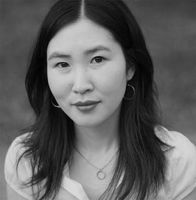The In Character Interview, with Leslie Shimotakahara
Leslie Shimotakahara's After the Bloom (Dundurn Press) has been praised as "personal and entrancing, unflinchingly shining a light on [a] difficult part of history" and "a sweeping page turner". The novel follows Rita Takemitsu, who is searching for her mother, Lily.
Lily disappeared without a trace one summer day, but the police refuse to take the disappearance seriously, citing Lily's memory problems and tendency to wander. Rita, knowing her mother's disappearance to be much more serious, pursues her own search. Her quest uncovers a web of family secrets around Lily's imprisonment at a California internment camp during the Second World War, and much more.
We're pleased to welcome Leslie to Open Book today to introduce us to Rita through our In Character interview series. Leslie tells us about the cost of covering up the past for Rita and Lily, where the title After the Bloom comes from, and her personal, family connection to the past wounds and secrets Rita uncovers.
Open Book:
Tell us about the main character in your new book.
Leslie Shimotakahara:
Rita Takemitsu is a recently divorced single mom and high school art teacher. Her relationship with her own mother, Lily, has always been strained, due to Lily’s refusal or inability to talk about the family’s past – their experience of being interned during the Second World War. When Lily mysteriously vanishes from her neighbourhood in Toronto one morning, Rita is compelled to go looking for her mother and in the process uncovers family secrets surrounding their time in the internment camp.
OB:
Some writers feel characters take on a "life of their own" during the writing process. Do you agree with this, or is a writer always in control?
LS:
I agree. I think that the early drafts of this novel suffered because I’d become overly attached to how my characters and storylines had been sketched out in outline form prior to the writing process. Opening myself up to the process of letting characters evolve organically, spontaneously – taking on a life of their own – has been a key lesson. At the same time, I believe that the writer has to maintain some sense of an overarching plan. Otherwise, the novel loses aesthetic coherence, characters veering off in too many random directions. It’s a delicate balance.
OB:
How do you choose names for your characters?
LS:
Rita is named after Rita Hayworth. We learn that Lily was obsessed with old movie stars. Lily’s name is an allusion to her lifelong hobby of ikebana (Japanese flower arranging). When I first imagined her as a character, I saw a slightly wilted lily in my mind, a lily after its bloom. So I suppose there’s an associative logic at work in my process of name selection.
OB:
What is your approach to crafting dialogue, particularly for your main character? Do you have any tips about writing dialogue for aspiring and emerging writers?
Your CanLit News
Subscribe to Open Book’s newsletter to get local book events, literary content, writing tips, and more in your inbox
LS:
Writing good dialogue is challenging. I begin by writing what seems natural, in terms of how I’d imagine a conversation between two real people playing out. Then I try to refine the dialogue, removing extraneous information, seeking to make the characters’ speech more allusive and subtle. It’s important to let the reader read between the lines.
OB:
Do you have anything in common with your main character? What parts of yourself do you see in him or her, and what is particularly different?
LS:
Like Rita, I have a longstanding fascination and curiosity about my family’s past, the internment period in particular. Virtually all my relatives of a certain generation were interned at camps at Sandon and Kaslo (ghost towns in British Columbia) and at Minidoka, Idaho. When I was growing up, at family dinners and birthday celebrations, one grandmother would tell strange, sad tales about the camp days – she was shameless about speaking out and didn’t care about making people uncomfortable – while the other grandmother always kept silent, debilitated by repressed memories and secrecy. Thus the internment, from early on, exerted a strong hold over my imagination. I’m glad that, unlike Rita, I at least had one family member willing to speak openly about what had happened.
OB:
Who are some of the most memorable characters you've come across as a reader?
LS:
Sofia and her mother, Rose, in Deborah Levy’s Hot Milk. The bizarre symbiotic relationship between this mother and daughter really drew me in. Also, Tony and Veronica in Julian Barnes’ The Sense of an Ending. The way that Barnes explores Tony’s remembrance of his younger self – by contrast to the alternate version of things that Veronica foists upon him – is utterly compelling.
OB:
What are you working on now?
LS:
A literary suspense novel set in Hong Kong. Over the past few years, I’ve been spending quite a bit of time in that city (my partner is from Hong Kong and returns there for work on a regular basis). This novel focuses on a young Chinese-Canadian woman’s gradual realization that her elderly father has done some pretty shady things to make the family fortune, when an anonymous figure from his past begins sending him threatening letters. The letters allude to the time he spent living in Guangzhou, China, between the Second World War and the Cultural Revolution, and the underhand means through which he managed to escape to Hong Kong.
____________________________
Leslie Shimotakahara’s memoir, The Reading List, was the winner of the Canada-Japan Literary Prize in 2012. Her fiction has been short-listed for the K.M. Hunter Artist Award. She holds a Ph.D. in English from Brown University. After the Bloom is her debut novel. Leslie lives in Toronto.





